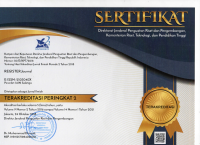The types and functions of code switching in a thesis defense examination
Abstract
This study investigated the acts of code switching by lecturers and student in thesis defence examination at a university in Banda Aceh, Indonesia. The study involved five participants (four lectures and one student) of the English Language Department. Data from recordings were used to analyse the types and functions of code switching that occurred during the defence. The types of code switching were analysed based on Poplack, and the functions of code switching were analysed based on the theories by Gumperz, Hoffman and Holmes. The result showed that there were three types of code switching found in 109 examples during the interactions between the lecturers and the student, they were: intra-sentential switching (77.06%), inter-sentential switching (15.59%), and tag switching (7.33%). In term of the functions of code switching, 10 functions were identified from 68 switches, they were: addressee specification at 22.05%, followed by interjections (16.17%), loanwords (16.17%), message qualifications (11.76%), transfer of the subconscious markers (8.82%), proper names (8.82%), quotations (5.88%), message reiteration (4.41%), personalization versus objectification (2.94%) and specific features of Islamic terms (2.94%) as the least. It can be concluded that in this case, code switching allowed the participants achieve a wide range of important and interesting ends in their discourse during the thesis defence examination.
Keywords
Full Text:
PDFReferences
Ahmad, B. H., & Jusoff, K. (2009). Teachers’ code-switching in classroom instructions for low English proficient learners. English Language Teaching, 2(2), 49-55.
Berthold, M., Mangubhai, F., & Batorowicz, K. (1997). Bilingualism & Multiculturalism: Study Book. Toowoomba: University of Southern Queensland.
Cook, V. (2001). Using the First Language in the Classroom. Canadian Modern Language Review, 57(3), 402-423.
Creswell, J. W. (2009). Research Design: Qualitative, Quantitative, and Mixed Methods Approaches (3rd Ed.). Los Angeles: Sage Publications, Inc.
Crystal, D. (2003). The Cambridge Encyclopedia of the English Language. Cambridge: Cambridge University Press.
Ellis, R. (1994). The Study of Second Language Acquisition. Oxford: Oxford University Press.
Ibrahim, E. H. E., Shah, M. I. A., & Armia, N. T. (2013). Code-switching in English as a foreign language classroom: Teachers’ attitudes. English Language Teaching, 6(7), 139-150.
Gumperz, J. J. (1982). Discourse Strategies: Studies in Interactional Sociolinguistics. Cambridge: Cambridge University Press.
Hancock, B. (2002). An Introduction to Qualitative Research. Nottingham: Trent Focus Group.
Heller, M. (Ed.). (1988). Codeswitching: Anthropological and Sociolinguistic Perspective. Berlin: Mouton de Gruyter.
Hoffman, C. (1991). An Introduction to Bilingualism. New York: Longman.
Holmes, J. (1992). Learning about Language: An Introduction to Sociolinguistics. London: Longman.
Jamshidi, A., & Navehebrahim, M. (2013). Learners’ use of code switching in the English as a foreign language classroom. Australian Journal of Basic and Applied Sciences, 7(1), 186-190.
Littlewood, W., & Yu, B. (2011). First language and target language in the foreign language classroom. Language Teaching, 44(1), 64-77.
Macaro, E. (2005). Codeswitching in the L2 classroom: A communication and learning strategy. In Llurda, E. (Ed.), Non-Native Language Teachers: Perceptions, Challenges, and Contributions to the Professions (pp. 63-84). Boston, MA: Springer.
Macaro, E. (2014). Students’ strategies in response to teachers’ second language explanations of lexical items. The Language Learning Journal, 42(1), 14–32.
McClure, E. (1981). Formal and functional aspects of the code switched discourse of bilingual children. In Duran, R. P. (Ed.), Latino Language and Communicative Behavior (pp. 69-94). Norwood, NJ: Ablex.
Meyerhoff, M. (2006). Introducing Sociolinguistics. London: Taylor & Francis.
Milroy, L., & Muysken, P. (1995). One Speaker, Two Languages: Cross-Disciplinary Perspectives on Code-Switching. Cambridge: Cambridge University Press.
Mujiono, Poedjosoedarmo, S., Subroto, E., & Wiratno, T. (2013). Code switching in English as foreign language instruction practiced by the English lecturers at universities. International Journal of Linguistics, 5(2), 46-65.
Myers-Scotton, C. (1993). Social Motivations for Codeswitching: Evidence from Africa. Oxford: Clarendon Press.
Numan, D. & Carter, D. (2001). Teaching English to Speakers of other Languages. Cambridge: Cambridge University Press.
Pillai, S., & Yusuf, Y. Q. (2012). An instrumental analysis of Acehnese oral vowels. Language and Linguistics, 13(6), 1029-1050.
Poplack, S. (1980). Sometimes I'll start a sentence in Spanish: Y TERMINO EN ESPAÑOL: Toward a typology of code-switching. Linguistics, 18, 581-618.
Ramos, A. L. (2010). Dynamics of code-switching in academic discourse: Evidences for Multilingual Education Bill. CNU Journal of Higher Education, 4(1), 12-23.
Richards, J. C. & Rogers, T. S. (2001). Approaches and Methods in Language Teaching. Cambridge: Cambridge University Press.
Romaine, S. (1995). Bilingualism (2nd Ed). London: Blackwell Publishing.
Sanchez, B. R. J. (2015). The Dynamics of Social Interaction in Telecollaborative Tandem Exchanges (Doctoral dissertation). University of Iowa, Iowa City, IA.
Skiba, R. (1997). Code switching as a countenance of language interference. Internet TESL Journal. Retrieved from http://iteslj.org/Articles/Skiba-CodeSwitching.html
Suan, O. K. (1990). A Study of Code-Switching among Bilingual Malay Students in Certain Urban Secondary Schools (Master’s thesis). University of Malaya, Kuala Lumpur.
Wardhaugh, R. (2006). An Introduction to Sociolinguistics (5th Ed.). Malden, MA: Blackwell Publishers.
Yusuf, Y. Q. (2013). A Comparative Study of Vowels in the Acehnese Language Spoken in Kedah, Malaysia and Aceh, Indonesia (Doctoral dissertation). University of Malaya, Kuala Lumpur.
Yusuf, Y. Q. (2009). A pragmatics analysis of a teacher’s code switching in a bilingual classroom. The Linguistics Journal, 4(2), 6-39.
DOI: http://dx.doi.org/10.30659/e.4.2.101-118
Refbacks
- There are currently no refbacks.
Copyright (c) 2019










